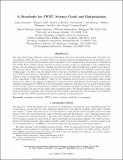A starshade for JWST: science goals and optimization
Author(s)
Seager, Sara; Cash, Webster; Brown, Robert A.; Jordan, Ian; Roberge, Aki; Glassman, Tiffany; Lo, Amy; Pueyo, Laurent; Soummer, Rémi; ... Show more Show less
DownloadSoummer-2009-A starshade for JWST science goals and optimization.pdf (475.7Kb)
PUBLISHER_POLICY
Publisher Policy
Article is made available in accordance with the publisher's policy and may be subject to US copyright law. Please refer to the publisher's site for terms of use.
Terms of use
Metadata
Show full item recordAbstract
The James Webb Space Telescope will be an extraordinary observatory, providing a huge range of exciting new astrophysical results. However, by itself it will not be capable of directly imaging planets in the habitable zone of nearby stars, one of the most fascinating goals of astronomy for the coming decade. In this paper we discuss the New Worlds Probe (NWP) concept whereby we use an external occulter (or starshade) to cast a shadow from the star onto the telescope, therefore canceling the direct star light while the light from a planet is not affected. This concept enables JWST to take images and spectra of extrasolar planets with sufficient contrast and inner working angle to be able to discover planets down to the size of the Earth in the habitable zone around nearby stars. JWST's instruments are appropriate to achieve low resolution spectroscopy (R ~= 40) of these planets, and address a series of fundamental questions: are there planets in the habitable zone around nearby stars? What is the composition of their atmosphere? What are the brightness and structures of exozodiacal disks around nearby stars? What is the mass and composition of currently known giant planets? In this paper we study the starshade optimization for JWST given the instrumental constraints, and show that the modest optical quality of the telescope at short wavelength does not impact the possibility of using a starshade. We propose a solution to enable imaging and spectroscopy using target acquisition filters. We discuss possible time allocation among science goals based on exposure time estimates and total available observing time. The starshade can be launched up to 3 years after JWST and rendezvous with the telescope in orbit around L2.
Date issued
2009-08Department
Massachusetts Institute of Technology. Department of Earth, Atmospheric, and Planetary SciencesJournal
Proceedings of the Society of Photo-optical Instrumentation Engineers ; v. 7440
Publisher
SPIE
Citation
Soummer, Remi et al. “A starshade for JWST: science goals and optimization.” Techniques and Instrumentation for Detection of Exoplanets IV. Ed. Stuart B. Shaklan. San Diego, CA, USA: SPIE, 2009. 74400A-15. ©2009 SPIE.
Version: Final published version
ISSN
0277-786X